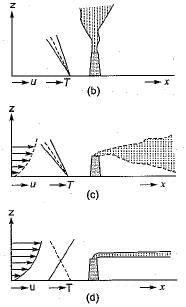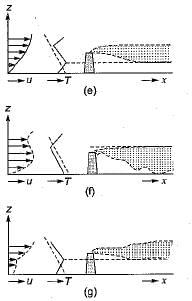Civil Engineering (CE) Exam > Civil Engineering (CE) Questions > Which one of the following plume behaviours o...
Start Learning for Free
Which one of the following plume behaviours occurs when atmospheric inversion begins from the ground level and continues?
- a)Looping
- b)Fumigation
- c)Coning
- d)Fanning
Correct answer is option 'D'. Can you explain this answer?
Verified Answer
Which one of the following plume behaviours occurs when atmospheric in...
1. When the ambient lapse rate is super - adiabatic (greater than the adiabatic), the turbulence of the air itself causes the atmosphere to serve as an effective vehicle of dispersion. As indicated in fig-a, the resultant plume is designated as a looping plume.
2. When the ambient lapse rate is equal to or very near the dry adiabatic lapse rate, the plume issuing from a single chimney or smokestack tends to rise directly into the atmosphere until it reaches air of density similar to that of the plume itself. This type emission, called a neutral plume, is seen in fig-b.
3. When the ambient lapse rate is sub-adiabatic (less than the dry adiabatic), the atmosphere is slightly stable. Under such conditions, there is limited vertical mixing, and the probability of air pollution problems in the area is increased. The typical plume in such a situation is said to be coning.
4. When the lapse rate is negative, as in the ' presence of an inversion, the dispersion of stack gas is minimal, because of lack of. turbulence. In the extremely stable air, a plume spreads horizontally, with little vertical mixing, and is said to be fanning (fig-d).
5. When the lapse rate is super-adiabatic above the emission source and inversion conditions, exist below the source, the plume is said to be lofting. As shown in fig-e, a lofting plume' has minimal downward mixing, and the pollutants are dispersed downwind without any significant ground-level concentrations.
6. When an inversion layer occurs at a short distance above the top of the stack and super adiabatic conditions prevail below the stack, then plume is said to be fumigating (fig-d).
7. When inversion layer exists above the emission source, as well as below the source, then naturally, the emitted plume will neither go up, nor will it go down and would remain confined between the two inversion (fig-g). Such a plume is called a trapping.




2. When the ambient lapse rate is equal to or very near the dry adiabatic lapse rate, the plume issuing from a single chimney or smokestack tends to rise directly into the atmosphere until it reaches air of density similar to that of the plume itself. This type emission, called a neutral plume, is seen in fig-b.
3. When the ambient lapse rate is sub-adiabatic (less than the dry adiabatic), the atmosphere is slightly stable. Under such conditions, there is limited vertical mixing, and the probability of air pollution problems in the area is increased. The typical plume in such a situation is said to be coning.
4. When the lapse rate is negative, as in the ' presence of an inversion, the dispersion of stack gas is minimal, because of lack of. turbulence. In the extremely stable air, a plume spreads horizontally, with little vertical mixing, and is said to be fanning (fig-d).
5. When the lapse rate is super-adiabatic above the emission source and inversion conditions, exist below the source, the plume is said to be lofting. As shown in fig-e, a lofting plume' has minimal downward mixing, and the pollutants are dispersed downwind without any significant ground-level concentrations.
6. When an inversion layer occurs at a short distance above the top of the stack and super adiabatic conditions prevail below the stack, then plume is said to be fumigating (fig-d).
7. When inversion layer exists above the emission source, as well as below the source, then naturally, the emitted plume will neither go up, nor will it go down and would remain confined between the two inversion (fig-g). Such a plume is called a trapping.




Most Upvoted Answer
Which one of the following plume behaviours occurs when atmospheric in...
Plume Behaviour: Fanning
Fanning is a plume behaviour that occurs when atmospheric inversion begins from the ground level and continues. It is characterized by the dispersion of the plume in a fan-like shape, with the plume spreading out horizontally as it rises. This type of plume behaviour is often seen in situations where there is a stable layer of air close to the ground that prevents the plume from rising vertically.
Causes of Fanning:
The fanning plume behaviour is caused by several factors, including:
1. Temperature inversion: Fanning occurs when there is a temperature inversion, which is a layer of warm air that sits on top of a layer of cool air. This inversion creates a stable layer of air that prevents the plume from rising vertically.
2. Wind direction: The direction of the wind is also a factor in fanning. When the wind blows at an angle to the plume, the plume will fan out in the direction of the wind.
3. Plume density: The density of the plume is another factor that can influence the fanning plume behaviour. If the plume is less dense than the surrounding air, it will tend to rise more vertically. If it is more dense, it will tend to fan out horizontally.
Impacts of Fanning:
The fanning plume behaviour can have several impacts, including:
1. Air pollution: Fanning can cause air pollution to spread over a larger area, potentially affecting more people and wildlife.
2. Climate change: Fanning can also contribute to climate change by spreading greenhouse gases over a larger area.
3. Visibility: Fanning can reduce visibility, making it difficult for people to see and navigate.
Conclusion:
In conclusion, fanning is a plume behaviour that occurs when atmospheric inversion begins from the ground level and continues. It is characterized by the dispersion of the plume in a fan-like shape, with the plume spreading out horizontally as it rises. Fanning can have several impacts, including air pollution, climate change, and reduced visibility.
Fanning is a plume behaviour that occurs when atmospheric inversion begins from the ground level and continues. It is characterized by the dispersion of the plume in a fan-like shape, with the plume spreading out horizontally as it rises. This type of plume behaviour is often seen in situations where there is a stable layer of air close to the ground that prevents the plume from rising vertically.
Causes of Fanning:
The fanning plume behaviour is caused by several factors, including:
1. Temperature inversion: Fanning occurs when there is a temperature inversion, which is a layer of warm air that sits on top of a layer of cool air. This inversion creates a stable layer of air that prevents the plume from rising vertically.
2. Wind direction: The direction of the wind is also a factor in fanning. When the wind blows at an angle to the plume, the plume will fan out in the direction of the wind.
3. Plume density: The density of the plume is another factor that can influence the fanning plume behaviour. If the plume is less dense than the surrounding air, it will tend to rise more vertically. If it is more dense, it will tend to fan out horizontally.
Impacts of Fanning:
The fanning plume behaviour can have several impacts, including:
1. Air pollution: Fanning can cause air pollution to spread over a larger area, potentially affecting more people and wildlife.
2. Climate change: Fanning can also contribute to climate change by spreading greenhouse gases over a larger area.
3. Visibility: Fanning can reduce visibility, making it difficult for people to see and navigate.
Conclusion:
In conclusion, fanning is a plume behaviour that occurs when atmospheric inversion begins from the ground level and continues. It is characterized by the dispersion of the plume in a fan-like shape, with the plume spreading out horizontally as it rises. Fanning can have several impacts, including air pollution, climate change, and reduced visibility.

|
Explore Courses for Civil Engineering (CE) exam
|

|
Question Description
Which one of the following plume behaviours occurs when atmospheric inversion begins from the ground level and continues?a)Loopingb)Fumigationc)Coningd)FanningCorrect answer is option 'D'. Can you explain this answer? for Civil Engineering (CE) 2025 is part of Civil Engineering (CE) preparation. The Question and answers have been prepared according to the Civil Engineering (CE) exam syllabus. Information about Which one of the following plume behaviours occurs when atmospheric inversion begins from the ground level and continues?a)Loopingb)Fumigationc)Coningd)FanningCorrect answer is option 'D'. Can you explain this answer? covers all topics & solutions for Civil Engineering (CE) 2025 Exam. Find important definitions, questions, meanings, examples, exercises and tests below for Which one of the following plume behaviours occurs when atmospheric inversion begins from the ground level and continues?a)Loopingb)Fumigationc)Coningd)FanningCorrect answer is option 'D'. Can you explain this answer?.
Which one of the following plume behaviours occurs when atmospheric inversion begins from the ground level and continues?a)Loopingb)Fumigationc)Coningd)FanningCorrect answer is option 'D'. Can you explain this answer? for Civil Engineering (CE) 2025 is part of Civil Engineering (CE) preparation. The Question and answers have been prepared according to the Civil Engineering (CE) exam syllabus. Information about Which one of the following plume behaviours occurs when atmospheric inversion begins from the ground level and continues?a)Loopingb)Fumigationc)Coningd)FanningCorrect answer is option 'D'. Can you explain this answer? covers all topics & solutions for Civil Engineering (CE) 2025 Exam. Find important definitions, questions, meanings, examples, exercises and tests below for Which one of the following plume behaviours occurs when atmospheric inversion begins from the ground level and continues?a)Loopingb)Fumigationc)Coningd)FanningCorrect answer is option 'D'. Can you explain this answer?.
Solutions for Which one of the following plume behaviours occurs when atmospheric inversion begins from the ground level and continues?a)Loopingb)Fumigationc)Coningd)FanningCorrect answer is option 'D'. Can you explain this answer? in English & in Hindi are available as part of our courses for Civil Engineering (CE).
Download more important topics, notes, lectures and mock test series for Civil Engineering (CE) Exam by signing up for free.
Here you can find the meaning of Which one of the following plume behaviours occurs when atmospheric inversion begins from the ground level and continues?a)Loopingb)Fumigationc)Coningd)FanningCorrect answer is option 'D'. Can you explain this answer? defined & explained in the simplest way possible. Besides giving the explanation of
Which one of the following plume behaviours occurs when atmospheric inversion begins from the ground level and continues?a)Loopingb)Fumigationc)Coningd)FanningCorrect answer is option 'D'. Can you explain this answer?, a detailed solution for Which one of the following plume behaviours occurs when atmospheric inversion begins from the ground level and continues?a)Loopingb)Fumigationc)Coningd)FanningCorrect answer is option 'D'. Can you explain this answer? has been provided alongside types of Which one of the following plume behaviours occurs when atmospheric inversion begins from the ground level and continues?a)Loopingb)Fumigationc)Coningd)FanningCorrect answer is option 'D'. Can you explain this answer? theory, EduRev gives you an
ample number of questions to practice Which one of the following plume behaviours occurs when atmospheric inversion begins from the ground level and continues?a)Loopingb)Fumigationc)Coningd)FanningCorrect answer is option 'D'. Can you explain this answer? tests, examples and also practice Civil Engineering (CE) tests.

|
Explore Courses for Civil Engineering (CE) exam
|

|
Signup for Free!
Signup to see your scores go up within 7 days! Learn & Practice with 1000+ FREE Notes, Videos & Tests.























